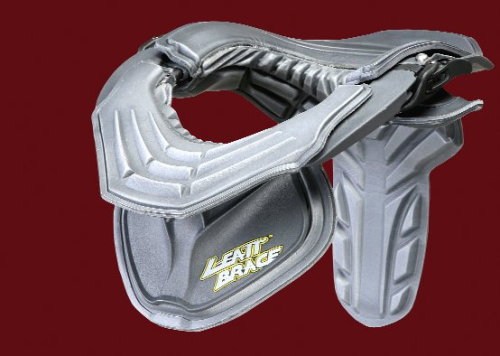MXA PRODUCT TEST: LEATT MOTOGPS ADVENTURE NECK BRACE: Less Money, But The Same Protection
LEATT ADVENTURE NECK BRACE

WHAT IS IT? An inexpensive version of the popular Leatt Moto GPX Sport and Club braces. It is designed to limit mobility and prevent serious neck injuries.
WHAT’S IT COST? $195.00.
CONTACT? (800) 691-3314 or www.leatt-brace.com.
WHAT’S IT DO? Chris Leatt, the inventor of the Leatt neck brace, is a pioneer in the neck protection sector of motocross safety. While foam neck rolls have been on the market for over a decade, Leatt’s rigid neck support system (similar to the HANS device) revolutionized the safety movement. The Leatt brace, however, wasn’t a winner right out of the gate. It wasn’t until David Bailey gave an impassioned endorsement of the brace that riders began to take a serious look at the concept of neck protection. Subsequent to Bailey’s message, sales skyrocketed for Leatt, and years after Bailey made the plea, Leatt’s sales have shown very little signs of slowing down.
Originally, Leatt intended to sell three models: The $395 Club, $595 Sport and a more expensive all-carbon fiber version. The major difference between the three models was the material used in their construction and the overall weight. The design would be virtually identical on the low-cost and the high-priced versions. The Club is made from a fiberglass reinforced plastic-like composite, while the Sport uses carbon fiber parts. The more expensive carbon fiber version was shelved for a new plan to introduce an entry-level Leatt brace that would bring the product to the public for $200 less than the Club model.
How well did the $195 Leatt ADVenture work? MXA’s goal was to find out.ÿÿÿ
WHAT STANDS OUT? Here’s a list of things that stand out with the Leatt Moto GPX ADVenture brace.
ÿÿ (1) Fit. The ADVenture brace uses the same design integrity and biomechanical function of the higher-priced Moto GPX braces. What is the difference? It lacks the fore and aft winglet adjustments of its brethren. The wings on the Club and Sport can be moved up or down, while the ADVenture is a static system. This is not a problem for riders who have never worn the adjustable Leatt braces, but for previous Leatt owners, they will not be able to customize the brace’s fit. This only presents a problem for riders with short necks. The ADVenture still offers three different length adjustments and the ability to change the angle on the back support from three degrees to ten degrees to 17 degrees.
ÿÿ (2) Construction. The ADVenture brace frame is made from fiberglass reinforced composite, while the wing material is a medium density rubber. The frame is composed of the same material as the Club and Sport, meaning that the brace is just as rigid and strong as the more expensive Leatt braces. Due to the dense rubber, the ADVenture brace weighs slightly more than the Club or Sport brace. The extra weight does not make a noticeable difference when riding.
ÿÿ (3) Target market. Leatt was quick to point out that the ADVenture brace is targeted towards weekend warriors, off-roaders and dual-sport riders. It is held to the same general safety standards as the Club and Sport, but simply lacks in adjustability.
ÿÿ (4) Place of manufacture. The Leatt ADVenture brace, like the Sport and Club, is made in China.
WHAT’S THE SQUAWK? Riders with shorter necks might find the lack of adjustment to be an issue, as the ADVenture limits side-to-side head movement.

Longtime Leatt neck brace wearers enjoyed the ADVenture brace and had no complaints. Newcomers to neck braces, as always, complained about limited mobility, but these complaints disappeared as they became accustomed to wearing the brace. This is a good brace at a very good price.






Comments are closed.